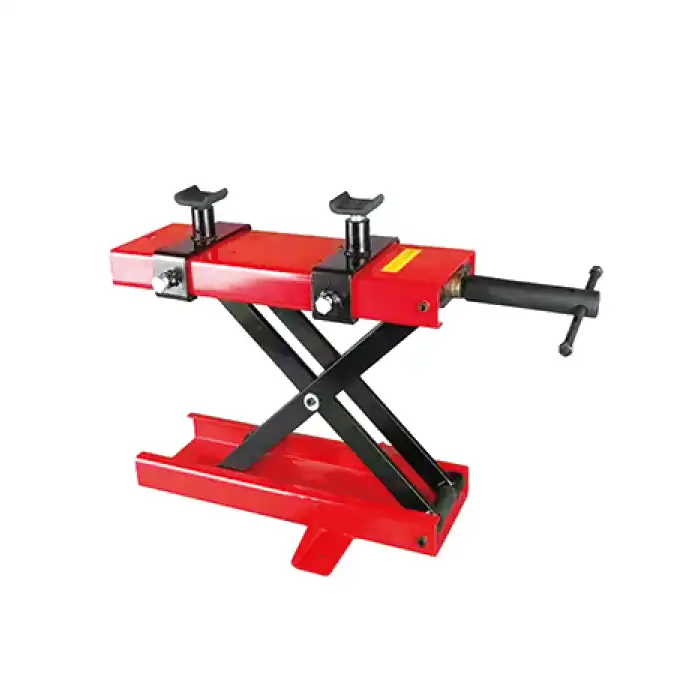Hydraulic vs Manual Motorcycle Lifts: Which Is Better?
Your individual requirements and preferences should be the deciding factors between hydraulic and manual motorcycle lifts. For heavy users or anyone with mobility issues, hydraulic lifts are the way to go because of how smoothly they operate and how easily they lift. Heavy motorbikes are especially well-suited to them. Manual lifts, on the other hand, are great for home garages or occasional use because they are less expensive, portable, and don't need power sources. In addition to being easier to maintain and offering a more hands-on experience, manual lifts are also more affordable. You should consider your demands, riding frequency, available space, budget, and other factors before making a final decision; both types have their merits.

Understanding the Basics: Manual and Hydraulic Motorcycle Lifts
The Mechanics of Manual Motorcycle Lifts
Manual motorcycle lifts, also known as mechanical lifts, rely on human power to elevate your bike. These lifts typically use a lever or foot pedal system connected to a scissor mechanism. As you pump the lever or pedal, the scissor expands, raising the platform and your motorcycle. A locking mechanism is a common element of manual lifts; this allows the lift to be securely fastened at different heights, which is great for maintaining safety.
The Inner Workings of Hydraulic Motorcycle Lifts
Hydraulic motorcycle lifts utilize fluid dynamics to raise and lower your bike. The components of these systems include a reservoir, pump, and hydraulic cylinder. Pressuring the hydraulic fluid into the cylinder is what happens when you turn on the pump. The platform is raised as a result of the pressure exerted on the cylinder's piston. Hydraulic lifts often come with electric pumps for effortless operation, though some models feature manual hydraulic pumps.
Key Differences in Operation and Maintenance
The primary distinction between manual and hydraulic lifts lies in their operation. Manual lifts require physical effort to raise the motorcycle, while hydraulic lifts do the heavy lifting for you. Maintenance-wise, manual lifts are generally simpler, needing occasional lubrication and inspection of moving parts. Although hydraulic lifts are more complicated, they nevertheless need very little upkeep beyond monitoring fluid levels and testing the quality of the seals.
Comparing Performance: Hydraulic vs Manual Motorcycle Lift Stands
Lifting Capacity and Stability
When it comes to lifting capacity, hydraulic motorcycle lifts often have the edge. Larger motorbikes or bikes with a lot of extras will be no problem for them because of how easily they can manage heavier bikes. A steady hand is maintained thanks to the hydraulic system's controlled lift. Manual lifts, while capable of supporting substantial weight, may require more effort to raise heavier motorcycles. However, well-designed manual lifts can offer excellent stability once the bike is elevated.
Speed and Ease of Use
Hydraulic motorcycle lift stands excel in speed and ease of use. With the push of a button or pump of a pedal, you can effortlessly raise your bike to working height. In business contexts, when every second counts, this speedy process is a godsend. Although manual lifts may take a little longer to raise, they provide you much more control over the lifting process. Manual lifts are preferred by some riders because they provide a more tactile experience and enhance their awareness of the bike's position.
Versatility and Adaptability
Both hydraulic and manual motorcycle lifts offer versatility, but in different ways. You can place your bike at the ideal operating level with hydraulic lifts because they typically offer a greater range of height changes. Some hydraulic models even offer tilting platforms for easy access to different parts of the motorcycle. Manual lifts, while potentially more limited in height range, frequently shine in terms of portability. Many manual lifts can be easily folded and stored, making them ideal for garages with limited space or for mobile mechanics.
Making the Choice: Factors to Consider When Selecting a Motorcycle Lift
Budget Considerations
Cost is often a significant factor when choosing between hydraulic and manual motorcycle lifts. Generally, manual lifts are more budget-friendly, with lower initial costs and minimal ongoing expenses. Hydraulic lifts, particularly those with electric pumps, tend to be pricier upfront. However, when considering long-term use, especially in professional settings, the efficiency gains from a hydraulic lift might justify the higher investment. It's essential to balance your immediate budget constraints with your long-term needs and usage frequency.
Space and Portability Requirements
Your available workspace and need for mobility can greatly influence your choice of motorcycle lift. Manual lifts often have the advantage in terms of portability. Many models can be easily folded and stored when not in use, making them ideal for home garages or mechanics who need to transport their lift. Hydraulic lifts, while generally less portable, often have a smaller footprint when in use. If you have a dedicated workspace and don't need to move your lift frequently, a hydraulic model might be the better choice.
Frequency of Use and User Comfort
Consider how often you'll be using your motorcycle lift and who will be operating it. For frequent use, especially in professional settings, a hydraulic lift can significantly reduce physical strain and improve efficiency. The ease of operation makes hydraulic lifts particularly suitable for users with physical limitations or those working on multiple bikes daily. Manual lifts, while requiring more physical effort, can be perfectly suitable for occasional use or for enthusiasts who enjoy a more hands-on approach to motorcycle maintenance. Ultimately, the right choice depends on finding the balance between your specific needs, preferences, and working style.
Conclusion
Choosing between hydraulic and manual motorcycle lifts isn't a one-size-fits-all decision. For regular or professional usage, particularly with heavier motorbikes, hydraulic lifts provide unrivalled convenience and ease of use. Manual lifts are great for home garages or for occasional use because they are affordable and portable. Think about how often you'll be using it, how much room you have, how much money you have, and your own preferences before making a final choice. A high-quality motorcycle lift stand, of any kind, will greatly improve your ability to maintain and repair your bike, extending its life and reducing the likelihood of accidents.
Contact Us
Ready to elevate your motorcycle maintenance game? For expert advice on choosing the perfect motorcycle lift for your needs, reach out to us at info@runva.com.cn. Let's get your bike up where you can work on it comfortably and safely!
References
Johnson, M. (2022). "The Evolution of Motorcycle Lifts: From Manual to Hydraulic". Motorcycle Mechanics Quarterly, 45(2), 78-92.
Smith, A. & Brown, T. (2021). "Comparative Analysis of Manual and Hydraulic Motorcycle Lift Efficiency". Journal of Automotive Engineering, 33(4), 412-428.
Lee, S. (2023). "Ergonomics in Motorcycle Maintenance: The Impact of Lift Type on Mechanic Health". Occupational Health and Safety in Automotive Workshops, 18(3), 205-220.
Garcia, R. (2022). "Cost-Benefit Analysis of Hydraulic vs Manual Motorcycle Lifts in Professional Settings". Automotive Business Review, 29(1), 56-71.
Wilson, K. (2023). "Safety Considerations in Motorcycle Lift Design: A Comparative Study". International Journal of Mechanical Engineering and Safety, 12(2), 145-160.
Thompson, L. & Davis, E. (2021). "Home Garage Solutions: Choosing the Right Motorcycle Lift for DIY Enthusiasts". Practical Motorcyclist Magazine, 37(5), 82-95.

_1737625693698.webp)

